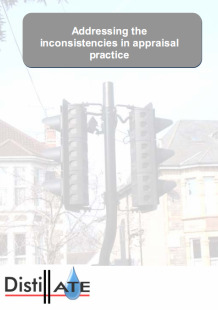Addressing the inconsistencies in appraisal practice
This document is one of the outputs of the DISTILLATE (Design and Implementation Support Tools for Integrated Local LAnd use, Transport and the Environment) research programme. DISTILLATE was funded under the EPSRC (Engineering and Physical Sciences Research Council) Sustainable Urban Environment Programme and is aimed at overcoming the barriers to the effective development and delivery of sustainable urban transport and land use strategies. This output is from DISTILLATE Project G - Enhanced Appraisal Methods.
During the development of the DISTILLATE programme, as well as from surveys carried out during the programme (as part of Project A - Organisational Behaviour and Barriers), appraisal was identified as a barrier to the development and delivery of sustainable urban transport and land use strategies by local authorities. Some of their concerns were technical aspects of appraisal (the dominance of travel time savings was the main one) as well as concerns about their ability to appraise some types of policy (including small schemes and behavioural and attitudinal measures) and to assess the distributional effects of proposals.
The following barriers were identified from the first and second Project A surveys and other stakeholder inputs:
- Some impacts are not well represented in appraisal
- We don’t know what the impacts of certain policy instruments are
- Appraisal/assessment methods for some policy instruments are not well developed
- Appraisal can be time consuming, onerous and expensive
- What should the relationship be between appraisal, VfM, and the choice of schemes to deliver policy?
- The distributional impacts of projects are not easy to represent in appraisal
1 and 2 were felt to be important issues, but of more general concern and with much wider implications; it was therefore decided not to pursue these further. There were also a couple of more technical issues:
- A concern about the accuracy of valuations
- Philosophical concerns about the valuation of impacts
Again, these are important (and the subject of considerable academic interest), but of less immediate concern to local authorities and therefore not a priority for the project.
From the remaining barriers it was decided to look into:
- The development of a method for the assessment of small schemes (this became Product G2)
- The representation of distributional issues in appraisal (Product G3)
- The role of appraisal in decision making (Product G4 – this document)
This guidance note starts from first principles in attempting to introduce the concept of appraisal, what it can be used for and how it is used in practice. It makes a series of recommendations based upon the analyses presented. It uses a number of terms of art which are defined in the glossary.

- Author(s): May, A.; Page, M.; Forrester, J.
- Year: 2008
- Download PDF
